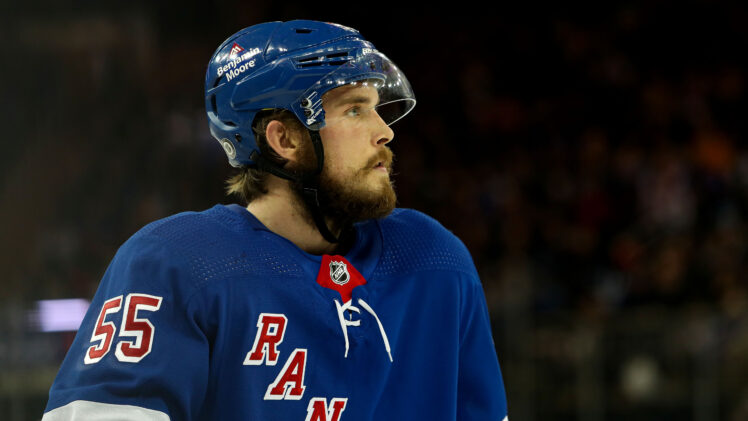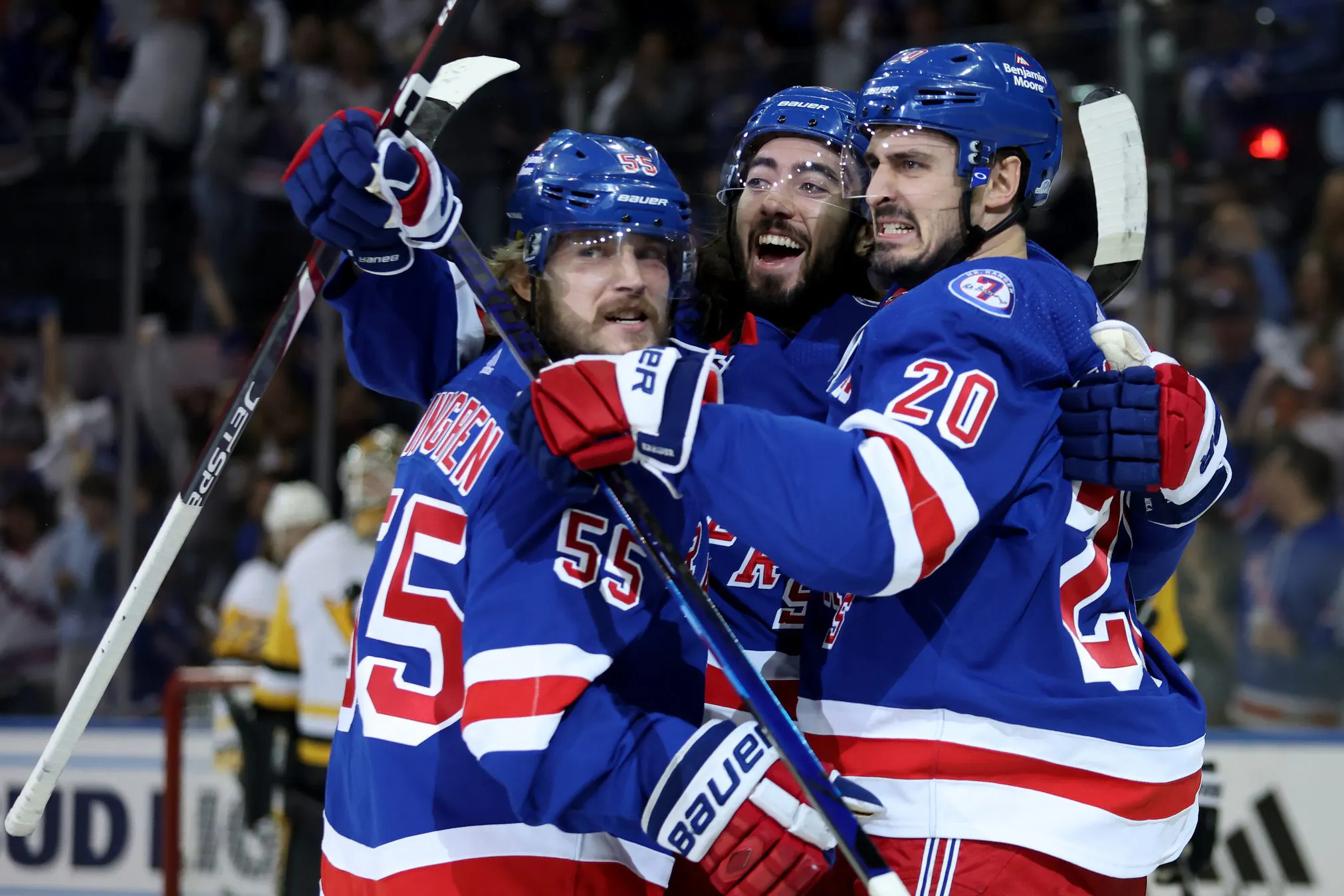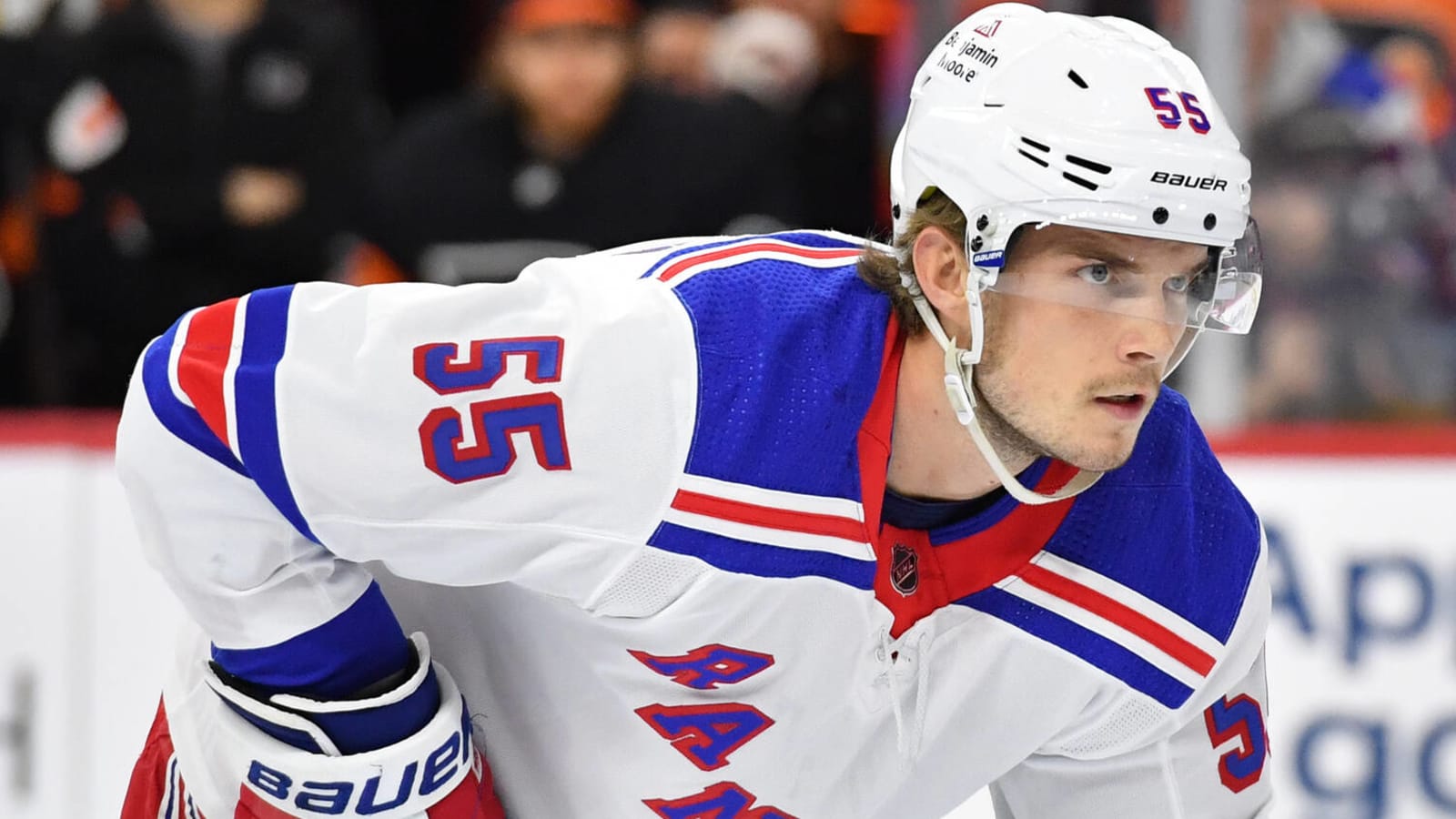Rangers Risk Repeat of Girardi Situation with a Lindgren Extension

“A warrior.”
“Tough as nails.”
“Our heart and soul.”
“The ultimate teammate.”
Present platitudes such as the above to any New York Rangers fan and ask him/her who on the roster comes to mind first. Ryan Lindgren would almost certainly be the most-named player in that hypothetical poll.
All of these descriptions do indeed fit the Blueshirts defenseman to a T. Pain is the norm for Lindgren, the fifth-year player and consistent left-side partner to Norris Trophy winner Adam Fox, yet he almost always bounces up off the ice and back out of the locker room after being banged up and bloodied. Lindgren’s ability to quickly resume his role as the club’s grittiest presence after getting knocked around stamps him as an NHL throwback, if there ever was one.
Lindgren is as tough as they come. There’s little doubt that his perseverance and refusal to let bumps, bruises, cuts and worse keep him from performing for his team serves as a source of inspiration for the Rangers, who see someone who provides total commitment night after night.

In this determined, salt-of-the-earth player, however, the organization is in danger of going down the same road it took a decade ago – to results that bordered on disastrous.
Lindgren and Girardi Come With Near-Identical Long-Term Risks
The player parallel, though not perfect, appears obvious. Dan Girardi was Lindgren before Lindgren, sacrificing his body unthinkingly to block shots, to battle in the dirty areas along the walls and in front of the net, to give and absorb hits to and from bigger players. With the same high pain tolerance as Lindgren, Girardi played three games of the 2015 Eastern Conference Final with a Grade 1 MCL sprain and answered the bell countless times to be there for his team, playing 80 or more games seven times.
The hockey DNA of the two players is nearly identical. Both were somewhat undersized and overlooked prospects, Girardi going undrafted in 2003 before signing with the Rangers off a training-camp invite in 2005, Lindgren being a second-round pick of the Boston Bruins in 2016 who was viewed as little more than a depth player and was considered a throw-in to the Rick Nash deadline trade in 2018.
Both players overcame perceptions about their potential with heart and determination, characteristics that can’t be measured by the cold analytical approach to player procurement that dominates major pro sports in the modern era, becoming key contributors to winning teams that challenged for Stanley Cups.
Yet those cold analytics that can’t measure the size of the fight in the dog proved to be right when they raised red flags about the wisdom of giving Girardi a contract extension in 2014 – and some of the same warning signs are popping up with Lindgren, with the 26-year-old set to become a restricted free agent with arbitration rights July 1.
The Rangers run the risk of allowing admiration for Lindgren’s contributions to cloud their judgment of whether to continue the relationship – which is precisely what happened almost exactly 10 years ago, in that case with Girardi set to hit unrestricted free agency that summer. Then-general manager Glen Sather, not exactly on the cutting edge of the emerging analytics revolution that was transforming sports, nonetheless played hardball with the fan favorite, making it clear he’d trade pending free agents who didn’t sign team-friendly extensions during the season.

Girardi and the Rangers managed to come to terms, agreeing to a six-year, $33 million contract Feb. 28, 2014. One week later, Sather showed that he hadn’t been bluffing, dealing captain Ryan Callahan to the Tampa Bay Lightning in a stunning move.
The supposedly team-friendly contract, however, ended up being anything but. While Girardi played all 82 games for the Presidents’ Trophy-winning Rangers in 2014-15, his play began to decline, with his countless injuries over the years appearing to catch up and the NHL becoming faster and faster around a player who was never known for his skating prowess. Three years into the deal, Sather’s successor Jeff Gorton executed a costly buyout after the 2016-17 season, leaving the Blueshirts with six years of dead salary-cap charges that only ended after last season.
he mistake in re-signing Girardi lay in the refusal to look past his human qualities as a great teammate, hard worker and “bleed blue” Ranger, and examine who the player actually was. Girardi was mostly teamed with Ryan McDonagh on the Rangers’ ostensible top pair – which, in hindsight, was not where Girardi belonged.
Rangers Must Put Sentiment Aside With Lindgren and Look at Data
Those pesky metrics show that Girardi was more often than not a liability and didn’t drive possession, his Corsi for numbers never reaching 50 percent after his second season and dropping to 37.3 in the 2015-16 season. His struggles during the 2014 postseason, when his progressive lack of mobility was consistently exposed, were an alarming development for a player about to begin a six-year extension the following season.

Making matters worse, the Rangers had unearthed an undervalued gem in Anton Stralman, like Girardi a right-side defenseman who signed with the club as a cheap free agent before the 2011-12 season and proceeded to post outstanding possession numbers over his three seasons in a Blueshirt. It was he and Marc Staal who took over as the matchup defense pair in the 2014 playoffs when Girardi’s lack of effectiveness left coach Alain Vigneault with little choice.
Stralman, outstanding in that Rangers’ run to the Stanley Cup Final, was allowed to leave after that season and signed a five-year contract with the Lightning, reportedly over a $500,000 difference in the negotiations. The lesson is clear now: Stralman, unflashy but ruthlessly efficient as evidenced by underlying numbers, was the better player than Girardi, which he proved with five mostly strong seasons in Tampa. Letting him walk after giving Girardi a bad contract had implications for the Rangers’ defense for years.
Which brings us back to Lindgren, who’s finishing up a three-year, $9 million bridge deal, and what can be applied from the Girardi episode. Again, it’s not an exact parallel. Lindgren is three years younger than Girardi was at the time of his free agency, and Lindgren’s skating has proved to be underrated – an overlooked reason why he’s made it in the NHL.
Still, there are just too many similarities to dismiss the comparison. Girardi’s nagging injuries, brought on by his all-out style of play, eventually sapped him of his physical presence; will the same happen as Lindgren ages? Will he still be popping back up from big hits into his 30s, where a long-term contract would take him?
Just as important is the fact that more extensive data is available today than a decade ago, and that data doesn’t paint a favorable picture of Lindgren’s impact. His career Corsi for – which is seen now as somewhat outdated as a metric – is only 45.2, and more advanced measurements aren’t on the Minnesota native’s side either.
According to Natural Stat Trick, since pairing up with Fox when both were rookies during the 2019-20 season and running through 2021-22, the duo posted a 49.5 Corsi for, with the Rangers outscoring opponents 116-82 and outchancing them 1,066-1,031 at even strength in 185 games over those three seasons.
However, a deeper look is considerably more revealing. In 203 games without Lindgren over that span, Fox posted a 52.4 Corsi for, with the Rangers outscoring opponents 52-44 and holding a 500-454 edge in scoring chances. Lindgren’s numbers without Fox in that same span? 45.0 Corsi for, with the Rangers tying opponents in goals at 23 and getting outchanced 260-225 in 189 games.
The numbers for the past two seasons are even more stark:

As a pair: 52.2 Corsi for, 65-42 edge in goals, 713 scoring chances for/656 against in 108 games
Fox without Lindgren: 56.5 Corsi for, 35-26 edge in goals, 440 scoring chances for/317 against in 129 games
Lindgren without Fox: 46.8 Corsi for, 19-16 edge in goals, Rangers outchanced 173-157, including 84-65 in high-danger chances, in 118 games
Five years of data deliver a clear, sobering conclusion: Fox carries the partnership and drags Lindgren along with him. On his own, Lindgren simply doesn’t drive positive play for the Rangers.

Leave a Reply